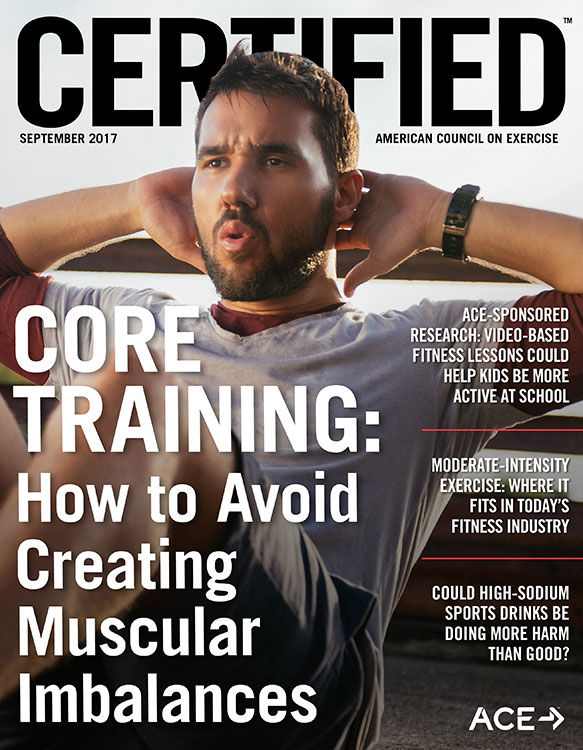
It used to be that every time I went for a run, I hated it. I couldn’t wait for those 30 or 40 minutes to be over. Like many fitness pros, I enjoy exercising, so I wasn’t sure what the struggle was—until I tried out a new activity tracker designed for running.
In testing the tracker—which measures heart rate, breathing efficiency, pace, distance, cadence and more—I got the opportunity to consult with a veteran running coach about my experience. He took one look at my tracker metrics and told me I was going too fast for my capabilities. Huh? I thought I was being an A+ student for running so fast, even if I did hate the pace. “Slow down,” he said. “It will help you become a better runner.”
So I did as he suggested, and at first my pace seemed embarrassingly slow. I wanted to speed up just to prove that I could! My workout mindset was: go hard, make it intense. Nevertheless, I stuck to a slightly slower pace, got better at it, and eventually began to like running. I suddenly felt motivated to do it.
In the process, I realized that I’d lost sight of the joy and benefits of moderate-intensity (and even light-intensity) exercise. Dare I suggest the fitness industry as a whole is in the same boat? It feels as if we’ve generally forgotten to exercise at a pace that’s anything less than full throttle, or that we should even consider it.
This article explores how and why our industry might have tipped the balance to favor a high volume of high-intensity exercise at the detriment of also doing light and moderate exercise. But here’s some good news: There’s a place for all of it.
When HIIT Came Along
When high-intensity interval training (HIIT) began to climb the ranks in fitness trends reports, it was a welcome change from the steady-state training that had previously dominated the industry. Fitness pros and consumers loved the concept! And rightly so—HIIT is exciting, time-efficient and effective. It has quickly become a positive addition to the industry. Meanwhile though, moderate, aerobic, endurance-based activities seem to have taken a back seat in terms of what’s “cool” or most beneficial. What happened?
“HIIT is [used] because of the shock-to-the-system value it gives through overload principles,” says Ken Baldwin, director of education and training at Perform Better Australia. He has more than 30 years of experience as a coach, personal trainer and fitness manager. “It gets results, in most cases, as the body is forced to make changes, and it does burn fat. Doing the same thing time and time again creates plateaus where the body remains in homeostasis and it only gives us what we need at that time; therefore, no overload and no results!”
In other words, years of mostly steady state set the stage for something new.
“The overall messaging of ‘go hard’ is a simple concept to market,” says Patrick Jak, M.S., director of metabolic testing at Fitness Quest 10 in San Diego, Calif., and coach for FitnessVantage and the University of California, San Diego Cycling Team. “It builds upon the decades-old, well-established stigma that still exists in the fitness industry: ‘No pain, no gain’ and ‘If you want results, you have to go hard.’”
While many health and fitness pros had begun to put the “no pain, no gain” mentality to rest about a decade ago, this mentality appears to be creeping back into fitness culture.
“It seems that every decade, the fitness industry swings from one emphasis to another,” says Jak. “Right now the push is on HIIT and high intensity. It’s like the industry can only focus on one thing at a time.”
While consumer demand has always been a driving force in fitness, it’s safe to say that fitness professionals are just as keen as consumers on the HIIT trend—perhaps even more so. Trainers and instructors generally like the feeling of physically pushing themselves, and HIIT is easy to program for a variety of clients.
“At clubs and conventions, there is now an overabundance of [HIIT] classes,” says Aileen Sheron, fitness entrepreneur, inventor of the OmniBall and international presenter whose fitness videos have sold in the millions. “Nearly every aspect of fitness has a boot-camp or circuit version, and it has become overused. The perception is: If this works, let’s do more, go harder, go heavier and take the theory to the limit. As the demand for these types of classes increases, there is pressure to provide more of them, so the trend continues to flourish.”
As a result, Sheron worries that people might be doing these workouts too frequently. The American Council on Exercise recommends performing one to two HIIT workouts per week.
“When a trend gains momentum in the industry, it just has to run its course until the negative aspects are experienced or until another approach takes its place,” says Sheron. Presumably, the majority of health and fitness pros and consumers would like HIIT to stay. For the sake of its longevity, we should keep touting HIIT’s benefits without overshadowing the significance of lower intensities, as well. They are in fact complementary.
“Low intensity is necessary because you can’t do high intensity all the time; that is not sustainable,” says Jason Karp, Ph.D., award-winning personal trainer, creator of the REVO2LUTION RUNNING certification and author of eight books, including Run Your Fat Off (Reader’s Digest Trade Publishing, 2017) and 14-Minute Metabolic Workouts (Skyhorse Publishing, 2017). “Low intensity is very sustainable for a person's entire life,” he says.
So are we back to steady state then? Fortunately, there’s no need to take sides.
“The industry should not necessarily place more emphasis on one versus the other but on understanding the need for balanced conditioning,” says Jak. “All individuals need to get both approaches.”
With that in mind, it might be time to ask if we’re overdue for a programming tweak: Teaching the advantages of scaling back sometimes. If we’ve been inadvertently sending the message that low and moderate intensities are somewhat irrelevant, it’s time to promote, or rather re-promote, their value in mainstream fitness.
Scaling Back as an Industry
To be clear: Health and fitness pros should keep teaching high-intensity exercise when appropriate. This article is not about ditching HIIT and high intensities. The suggestion to scale back isn’t about giving clients a free pass to slack off. It’s about deliberate training for desired results.
“We need to continue to stress the importance of high intensity, hard work and being willing to sweat a little for a change,” says Jak. “But we can no longer eschew low intensity. It has too many benefits. I think we need to insist on balancing high and low intensity at the right dosing for the individual client. There is a time and place for both levels of effort.”

 Yes, but many clients are hooked on HIIT and don’t see the advantage of adopting any other pace. So, we must do a better job at “selling” it to them. For example, high-level athletes seeking peak performance don’t go all-out, all the time. There’s a system to their training that includes lower intensities. Coming from an endurance athletic background and the world of competitive cycling, Jak explains why lower intensities ultimately help individuals achieve higher levels of health, fitness and performance.
Yes, but many clients are hooked on HIIT and don’t see the advantage of adopting any other pace. So, we must do a better job at “selling” it to them. For example, high-level athletes seeking peak performance don’t go all-out, all the time. There’s a system to their training that includes lower intensities. Coming from an endurance athletic background and the world of competitive cycling, Jak explains why lower intensities ultimately help individuals achieve higher levels of health, fitness and performance.
“In cycling, we spend a large amount of our time in lower-intensity levels. This helps us work on technique, metabolize fuel more efficiently, and lay down a foundation for our speed and intensity work,” says Jak. “More time is spent in lower intensity than higher intensity in order to develop an aerobic base. The bigger the base, the higher the peak.”
While you don’t have to train the average client like a competitive athlete, you can still borrow from this playbook. Remind fit clients who are averse to going slower that lower intensities aren’t just for “beginners.” There are many reasons why fit people should mix light and moderate intensities into their overall routines.
“It comes back to all systems of the body requiring a slower or lighter load to allow the body to rebuild,” says Baldwin.
Karp makes the case with competitive running: “Slow runs are relaxing and restorative, building your body up (in contrast to high intensity, which wears the body down),” he says. “When done right, and with patience and intention, slow runs lay the foundation for much faster running to come later.”
Not everyone loves to “feel the burn” anyway. High intensities come with a host of benefits and are famously time efficient, but they’re perhaps more likely to stamp out motivation for already reluctant exercisers.
“Although high-intensity exercise can be very beneficial, it is in contrast to human nature,” says Karp. “People would rather go long at a low intensity than short at a high intensity, for many reasons, not the least of which is that high-intensity exercise is physically uncomfortable and, while that can be a good thing, people tend to shy away from what is physically uncomfortable.”
My running story at the beginning of this article illustrates Karp’s point. Adds Jak, “When moving is equated to exhaustion, the majority of the population will just skip everything.”
Revisiting Light and Moderate Intensities
With the current emphasis on high intensities, the fitness industry might need to begin pushing a little harder about the importance of balancing cardiovascular efforts.
“Low intensity is not just for active recovery between high-intensity intervals,” says Jak. “It is for more than just warming up and cooling down.”
And, harking back to the example of how serious athletes train, it’s not just for the unfit.
“There is a lot of research to show that light/moderate exercise is physically beneficial for everyone,” says Karp. “The health benefits are wide and deep, from improved blood lipid profiles to improved cognitive function.”
More intensity, however, doesn’t necessarily translate to better exercise.
“There is a clear difference of physiological response and demand during low-, moderate-, and high-intensity cardiovascular exercise,” says Jak. “Substrates, hormones, enzymes all differ. Balancing the various levels of intensity is essential to cardiovascular health.” (For a more detailed look at research on the physiological benefits of light and moderate activity, see Don’t Call it a Comeback: Moderate-intensity Exercise is Still Effective.)
Got a client who wants results from the hard work they put in? (Don’t we all?) Baldwin reminds us that the body repairs itself at rest, not when it’s still overloaded and stressed.
“Lower ranges of exercises or moderate exercise lead to greater recovery and longevity of muscles and fascia, and allow the bones to be rebuilt stronger along stress lines instead of being broken down,” he says.
Jak also emphasizes the importance of recovery. “I have run metabolic tests on athletes before training camps, during season and after a season,” says Jak. “At the end of a major block of high-intensity work or season, the body is wrecked and in bad need of recovery. They are stressed, not processing fuel well, not economical, not efficient, and on the verge of illness and/or injury. Once they return to some low-intensity work, however, their bodies respond incredibly well and the fatigue, soreness and poor performance subside. Now imagine what someone who also has a busy, demanding family and works in a high-stress career will go through.”
Of course, the need for recovery and downtime isn’t just physical—it can be psychologically freeing as well.
“Slow runs separate the body from the mind,” says Karp. “They give you a chance to think and reflect on things, events and people in your life.”
In other words, slowing down offers people a chance to weave wellness into their routines. In the gym, this change of pace might make for a refreshingly low-pressure, low-key workout.
“High-intensity training requires the right mindset and focus to perform the exercises correctly,” says Sheron. “With moderate activity, you don’t have to worry about psyching up to simply complete the activity, and the risk of injury is far lower.” Clients might also have an easier time with technique mastery at a lower-intensity level.
Part of Every Program
One of the fitness industry’s major objectives is to help more people enjoy fitness. So why not equip them with as many options for success as possible? Lower intensity might not be the next big buzz-worthy trend, but it’s still infinitely valuable to all of us.
“Adding low-intensity conditioning helps an individual reach higher levels of intensity,” says Jak. “You can’t have one without the other and find your true potential.”





 by
by 

 Yes, but many clients are hooked on HIIT and don’t see the advantage of adopting any other pace. So, we must do a better job at “selling” it to them. For example, high-level athletes seeking peak performance don’t go all-out, all the time. There’s a system to their training that includes lower intensities. Coming from an endurance athletic background and the world of competitive cycling, Jak explains why lower intensities ultimately help individuals achieve higher levels of health, fitness and performance.
Yes, but many clients are hooked on HIIT and don’t see the advantage of adopting any other pace. So, we must do a better job at “selling” it to them. For example, high-level athletes seeking peak performance don’t go all-out, all the time. There’s a system to their training that includes lower intensities. Coming from an endurance athletic background and the world of competitive cycling, Jak explains why lower intensities ultimately help individuals achieve higher levels of health, fitness and performance.
